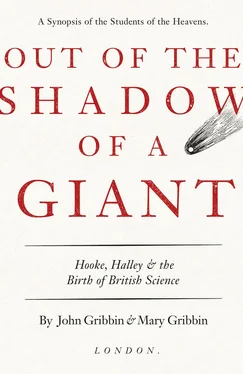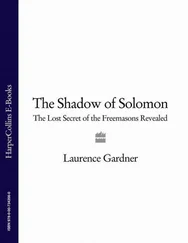Introduction: Out of the Shadows
A Note on Dates
Chapter 1: From Freshwater to Oxford
Chapter 2: The Most Ingenious Book That Ever I Read In My Life
Chapter 3: Monumental Achievements
Chapter 4: Meanwhile …
Chapter 5: From Hackney to the High Seas
Chapter 6: Of Spring and Secretaryship
Chapter 7: A Mission of Gravity
Chapter 8: Halley, Newton and the Comet
Chapter 9: Not Fade Away
Chapter 10: To Command a King’s Ship
Chapter 11: Legacies
Coda: How to do Science
Picture Section
Footnotes
Bibliography
Index
Acknowledgements
About the Publisher
INTRODUCTION
OUT OF THE SHADOWS
Isaac Newton famously commented that if he had seen further than other people it was ‘by standing on the shoulders of giants’. But even within his own lifetime, and increasingly since then, Newton was widely acknowledged as the greatest of all scientific giants, to such an extent that the remarkable achievements of his colleagues and contemporaries are often overlooked. Two of the pioneering scientists who lived and worked in the shadow of Newton would each have been regarded as giants in their own right if he had not been around, and it is our intention to bring them out of Newton’s shadow to put their achievements in perspective. They are (in chronological order) Robert Hooke (1635–1703), who was slightly older than Newton (1642–1727), and Edmond Halley (1656–1742), who outlived Newton. Their overlapping lives neatly embrace the hundred years or so during which science as we know it became established in Britain.
But what of Newton? He was, to say the least, economical with the truth, and attempted to write Robert Hooke out of history, having ‘borrowed’ many of Hooke’s best ideas. It has been established, for example, that the famous story of the falling apple seen during the plague year of 1665 is a myth, invented by Newton to bolster his (false) claim that he had the idea of a universal theory of gravity before Hooke. In fact, Hooke described such an idea, and the rule that every object (such as a planet) moves in a straight line unless acted upon by some outside force (ironically, now known as Newton’s First Law), in the mid-1660s, when Newton was an unknown and very junior member of Cambridge University (he only graduated in 1665). Until Hooke mentioned these ideas to Newton several years later, Newton subscribed – as surviving documents show – to the idea that planetary motion was caused by whirlpools in some kind of fluid filling the Universe. Newton also lifted much of Hooke’s work on light and colours, and Newton published (significantly, immediately after Hooke’s death) as ‘his’ own theory of heat, an idea that has been described by historian Clara de Milt as ‘very, very’ like Hooke’s earlier work. In one respect, though, Newton was a better scientist than Hooke: he was a brilliant mathematician. And he outlived Hooke, so he had the last word – until now.
We have not attempted to provide complete biographies of our subjects, who have been well served in that regard by Lisa Jardine (Hooke) and Alan Cook (Halley); our focus is on their scientific achievements, and how these were fundamental to the development of science in England. But there is, we hope, enough biographical background here to give some insight into the kind of people they were, and how they were both, in their different ways, products of the society they lived in.
Hooke has been described as ‘England’s Leonardo’, a polymath whose achievements extended far beyond the realm of science. He came from a poor but respectable background, the son of a curate on the Isle of Wight. With the aid of a modest inheritance, he was able to attend Westminster School, and go on to Oxford as a choral scholar without having to pay fees. This was in 1653, during the Parliamentary Interregnum, and since music was banned in church services at the time he got the scholarship without having to sing for it. He eked out a living by acting as a paid servant for one of the wealthier undergraduates, normal practice at that time. He then moved on to become assistant to Robert Boyle, the ‘father of chemistry’. It is now widely accepted that it was Hooke who discovered what is now known as ‘Boyle’s Law’ of gases; Hooke was the only one of Boyle’s various paid assistants to be credited by name in his writings. Through Boyle, Hooke became a member of the inner circle of British scientists of the day, and became the first Curator of Experiments at the Royal Society. He was the man who made the Society a success, but (perhaps because of his humble background) he was always touchy about priority and famously got involved in rows with Newton and the Dutch scientist Christiaan Huygens. Hooke pioneered the use of the microscope, wrote the first popular science book (praised by Samuel Pepys), made astronomical observations, and kept the Royal running. One of his great friends was Christopher Wren, and after the Fire of London the two of them worked together on the rebuilding of the City – many ‘Wren’ churches are now thought to be Hooke’s work. Hooke was the best experimental scientist of his time, the leading microscopist of the seventeenth century, an astronomer of the first rank, and developed an understanding of earthquakes, fossils and the history of the Earth that would not be surpassed for a century.
Edmond Halley is remembered today for the comet that bears his name, but, like Hooke, he had several strings to his bow. Halley came from a relatively prosperous background, did well at school, and went up to Oxford in 1673. There, he was able to indulge his passion for astronomy by taking with him equipment including a telescope and sextant that would have been the envy of a contemporary professional astronomer. His work impressed John Flamsteed, the first Astronomer Royal, and with his (and other) help Halley was able to wangle a trip to the island of St Helena to carry out a survey of the southern skies. His father provided an allowance of £300 a year (three times Flamsteed’s salary!), the degree was abandoned, and at the age of twenty Halley went off on his adventure. The survey was a great success, with Halley’s Catalogue of the Southern Stars establishing his reputation. The King ‘recommended’ that Halley be given a degree, which was awarded three days after he was elected as a Fellow of the Royal Society. He was not, however, in a hurry to build on this success. Comfortably supported by his father, he led the life of a gentleman in Restoration England, including the Grand Tour of Europe, before settling down, getting married and publishing astronomical observations from his home in Islington. The death of his father (in suspicious circumstances) in 1684 brought a change of priorities, and Halley became more involved with the work of the Royal Society. It was around this time that Halley, Hooke and Wren, puzzling over the nature of planetary orbits, asked Newton if he could explain why they seemed to be governed by an inverse square law. This led to the publication, overseen and funded by Halley, of Newton’s great work, the Principia . Alongside all this, Halley carried out a survey of the Thames estuary and invented a practical diving bell. He made the first scientific estimate of the size of atoms, calculated how to work out the distance to the Sun from a transit of Venus, and set out on an official voyage of exploration to the southern seas – a predecessor of the famous Beagle voyage. But, unlike Darwin, he was not a mere passenger; he was given a King’s ship and made Master and Commander (in modern language, a Royal Navy Captain) to run it, the only ‘landsman’ ever to hold such a post. This led to secret work as a spy (the details are lost) in the Adriatic, and then his appointment as a Professor at Oxford University. His life became less exciting, although it was recorded that he ‘talks, swears, and drinks brandy like a sea captain’. But there remained many scientific contributions, including the prediction of the return of ‘his’ comet and Halley’s appointment as the second Astronomer Royal, in 1720.
Читать дальше












